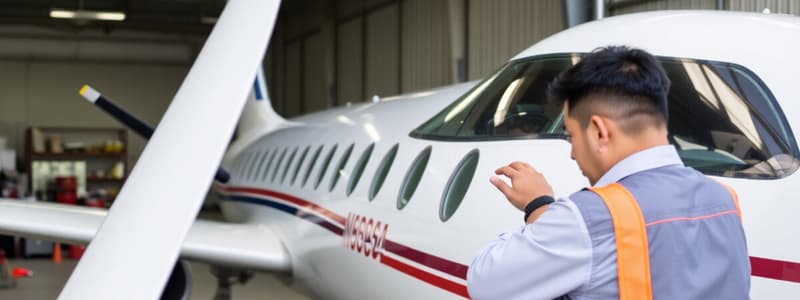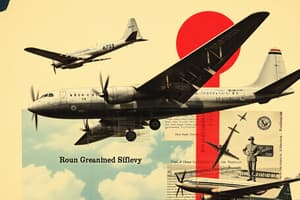Podcast
Questions and Answers
The ____ of the aircraft should be checked for cracks before flight.
The ____ of the aircraft should be checked for cracks before flight.
fuselage
Make sure to ____ the luggage securely in the overhead compartments.
Make sure to ____ the luggage securely in the overhead compartments.
- close
- place
- fix
- stow (correct)
Pilots always check the ____ conditions before departure
Pilots always check the ____ conditions before departure
- weather (correct)
- turbulence
- traffic
- cargo
______ can cause surface damage to an airplane.
______ can cause surface damage to an airplane.
Which of the following is NOT part of an airplane?
Which of the following is NOT part of an airplane?
Which of the following is used for safety during an emergency?
Which of the following is used for safety during an emergency?
Which of the following is checked before every flight?
Which of the following is checked before every flight?
Which of the following is NOT a dangerous good?
Which of the following is NOT a dangerous good?
Engineers ____ inspect the aircraft before every flight.
Engineers ____ inspect the aircraft before every flight.
Passengers ____ wear heavy jackets during evacuation.
Passengers ____ wear heavy jackets during evacuation.
Pilots ____ communicate with air traffic control during the flight.
Pilots ____ communicate with air traffic control during the flight.
The ____ gear supports the airplane during landing.
The ____ gear supports the airplane during landing.
Foreign ____ on the runway can damage the airplane.
Foreign ____ on the runway can damage the airplane.
A _____ object can cause significant problems during takeoff.
A _____ object can cause significant problems during takeoff.
The _____ of the aircraft determines its speed and altitude.
The _____ of the aircraft determines its speed and altitude.
Passengers are advised to remain ____ during turbulence
Passengers are advised to remain ____ during turbulence
Which of the following weather conditions affects visibility?
Which of the following weather conditions affects visibility?
Which of the following is NOT a routine procedure?
Which of the following is NOT a routine procedure?
Which of the following is related to air pressure?
Which of the following is related to air pressure?
The ____ edge of the wing is inspected for damage.
The ____ edge of the wing is inspected for damage.
Passengers must keep the ____ closed during takeoff.
Passengers must keep the ____ closed during takeoff.
Pilots monitor the ____ speed during approach.
Pilots monitor the ____ speed during approach.
Flight attendants demonstrate how to use ____ masks.
Flight attendants demonstrate how to use ____ masks.
The ____ kit is stored securely in the cabin.
The ____ kit is stored securely in the cabin.
Flashcards
Fuselage
Fuselage
The main body or structure of an aircraft.
Stow Luggage
Stow Luggage
To store luggage securely in designated compartments.
Weather Conditions
Weather Conditions
The atmospheric conditions that pilots consider before flying.
Engine Blades
Engine Blades
Signup and view all the flashcards
Lightning Strike
Lightning Strike
Signup and view all the flashcards
Undercarriage
Undercarriage
Signup and view all the flashcards
Life Jacket
Life Jacket
Signup and view all the flashcards
Pre-flight Checks
Pre-flight Checks
Signup and view all the flashcards
Dangerous Goods
Dangerous Goods
Signup and view all the flashcards
Engineers Inspect Aircraft
Engineers Inspect Aircraft
Signup and view all the flashcards
Passenger Jackets During Evacuation
Passenger Jackets During Evacuation
Signup and view all the flashcards
Pilot Communication
Pilot Communication
Signup and view all the flashcards
Foreign Objects on the Runway
Foreign Objects on the Runway
Signup and view all the flashcards
Takeoff Obstacles
Takeoff Obstacles
Signup and view all the flashcards
Aircraft Engine
Aircraft Engine
Signup and view all the flashcards
Passengers During Turbulence
Passengers During Turbulence
Signup and view all the flashcards
Overcast Weather Visibility
Overcast Weather Visibility
Signup and view all the flashcards
Routine Procedures
Routine Procedures
Signup and view all the flashcards
Air Pressure Measurement
Air Pressure Measurement
Signup and view all the flashcards
Leading Edge Inspection
Leading Edge Inspection
Signup and view all the flashcards
Aircraft Doors During Takeoff
Aircraft Doors During Takeoff
Signup and view all the flashcards
Wind Speed Monitoring
Wind Speed Monitoring
Signup and view all the flashcards
Oxygen Mask Demonstration
Oxygen Mask Demonstration
Signup and view all the flashcards
First Aid Kit
First Aid Kit
Signup and view all the flashcards
Main Body of the Aircraft
Main Body of the Aircraft
Signup and view all the flashcards
Safe Luggage Storage
Safe Luggage Storage
Signup and view all the flashcards
Weather Impact on Flight Safety
Weather Impact on Flight Safety
Signup and view all the flashcards
Engine Blades and Power
Engine Blades and Power
Signup and view all the flashcards
Lightning Strike Effects
Lightning Strike Effects
Signup and view all the flashcards
Undercarriage Function
Undercarriage Function
Signup and view all the flashcards
Life Jacket Importance
Life Jacket Importance
Signup and view all the flashcards
Pre-Flight Check Importance
Pre-Flight Check Importance
Signup and view all the flashcards
Study Notes
Aviation English Final Exam Notes
-
Aircraft Inspection: The fuselage, cockpit, and tail of an aircraft should be checked for cracks before flight.
-
Luggage Handling: Luggage should be stowed securely in overhead compartments.
-
Pre-Flight Procedures: Pilots inspect the blades for wear, and weather conditions are checked before departure.
-
Aircraft Maintenance: Landing gear, engines, and undercarriage are checked for maintenance. Lightning strikes can cause damage.
-
Airplane Parts: An automobile is not a part of an airplane.
-
Emergency Equipment: A life jacket is used for safety in emergencies.
-
Routine Checks: Surfaces, hatches, and weather conditions are checked before each flight.
-
Dangerous Goods: Explosives, toxic chemicals, and flammable liquids are classified as dangerous goods, whereas a first aid kit isn't.
-
Pre-Flight Checks: Engineers are responsible for thorough pre-flight checks on the aircraft.
-
Passenger Safety: Passengers are required to wear heavy jackets during evacuations.
-
Pilot Communication: Pilots must communicate with air traffic control during flight.
-
Landing Gear: The undercarriage supports the aircraft during landing.
-
Foreign Objects: Foreign objects on the runway can damage the aircraft.
-
Takeoff Hazards: Heavy or sharp objects can cause problems during takeoff.
-
Aircraft Performance: The engine determines an aircraft's speed and altitude.
-
Turbulence Procedures: Passengers should remain seated during turbulence.
-
Weather and Visibility: Overcast weather conditions can affect visibility.
-
Routine Procedures/Emergency Procedures: Refueling, stowing dangerous goods, and pre-flight checks are routine; skipping safety briefings isn't.
-
Air Pressure: Air pressure is measured in hPa (hectopascals).
-
Wing Inspection: Damage check of the leading edge of the wing is essential.
-
Takeoff Procedures: Passengers need to keep seats and hatches closed during takeoff.
-
Flight Monitoring: Pilots monitor wind and turbulence during approach.
-
Safety Equipment: Flight attendants demonstrate the use of oxygen masks.
-
Cabin Storage: The first aid kit is securely stored in the cabin.
Studying That Suits You
Use AI to generate personalized quizzes and flashcards to suit your learning preferences.




